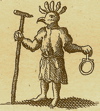 Johann Dieter Wassmann, Schutzen Euere Klempnerarbeit (Protect Your Plumbing), 1883. 70 x 49.5 x 7 cm.
Johann Dieter Wassmann, Schutzen Euere Klempnerarbeit (Protect Your Plumbing), 1883. 70 x 49.5 x 7 cm.“[Johann Dieter] Wassmann created his first box works in 1881. As an engineering lecturer at the University of Leipzig, he was anxious that creative thinking was being discouraged from education. Relying on the Enlightenment understanding that ‘knowledge is… a kind of visual field and that vision, like science, illuminates reason,’ [Robert Schubert, Brief notes on radical evil, Australian Centre for Contemporary Art, 1997] he attempted to attract his young male students’ attention by juxtaposing peculiar diagrams of the human body from medical journals, bottles, medical instruments and other paraphernalia in odd ways. Works like Protect your Plumbing 1883 and Amputare 1881 were to encourage interest in dealing with issues like syphilis and the treatment of infectious disease (respectively), but also to encourage questions towards modern medical practice and the way it viewed and treated the human body. Foucault’s Pendulum 1884, demonstrating the earth’s rotation, indicates broader concerns which transpired in his later works. After hanging in a Dresden clinic for some time, these became known as the Dresden Boxes (1881-85).
“Wassmann recognised the power of objects through his fascination and, as times changed, a humanist concern for the loss of imagination. In order to subvert the logic and rationality of industrialisation, he juxtaposed everyday, discarded objects in often unexpected relations to allow them to act as conduits to individual consciousness. Sitting in their boxes, the now fetishised objects elicited personal narratives from the viewer, sometimes with unsuspected and/or revelatory connections.
“It is also interesting to note his use of a grid-like device to compartmentalise his objects and images. A practicing sewerage engineer, Wassmann thought nothing of using a grid as an ordering principle for keeping waste and disease away from the populace. But in his art-work it was a visual device used to delineate space and simplify viewing, as well as instigating questions of the Enlightenment association between perception and knowledge in a clever, sometimes amusing, way. This was to become an important symbol of Modernism, particularly with artists like Malevich (Suprematism) and Mondrian (De Stihl), who saw it as a spiritually liberating organising principle, and the American abstractionist (Josef Albers, Sol Le Witt), who used it as a structural format emphasising form, colour (light) and space.”
Kirsten Rann, curator
Bleeding Napoleon: The Art of Johann Dieter Wassmann (1841-1898) exhibition brochure, 2003
Melbourne International Arts Festival 2003
 Johann Dieter Wassmann, Foucault’s Pendulum, 1884. 40 x 45 x 33.5 cm.
Johann Dieter Wassmann, Foucault’s Pendulum, 1884. 40 x 45 x 33.5 cm.

No comments:
Post a Comment